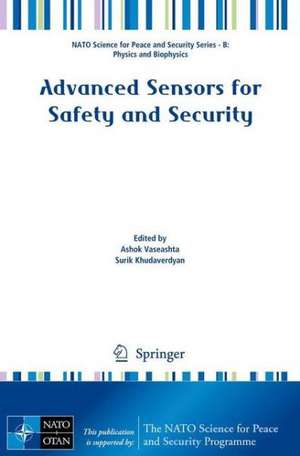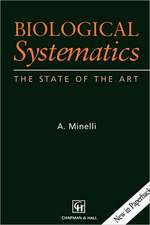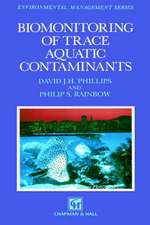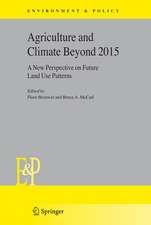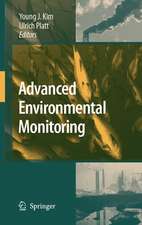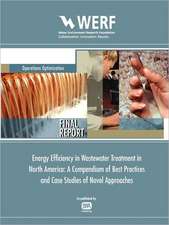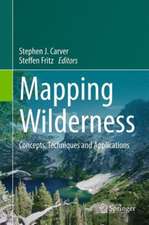Advanced Sensors for Safety and Security: NATO Science for Peace and Security Series B: Physics and Biophysics
Editat de Ashok Vaseashta, Surik Khudaverdyanen Limba Engleză Paperback – 8 aug 2013
| Toate formatele și edițiile | Preț | Express |
|---|---|---|
| Paperback (1) | 1222.01 lei 6-8 săpt. | |
| SPRINGER NETHERLANDS – 8 aug 2013 | 1222.01 lei 6-8 săpt. | |
| Hardback (1) | 1225.94 lei 6-8 săpt. | |
| SPRINGER NETHERLANDS – 12 aug 2013 | 1225.94 lei 6-8 săpt. |
Din seria NATO Science for Peace and Security Series B: Physics and Biophysics
- 18%
 Preț: 955.25 lei
Preț: 955.25 lei - 18%
 Preț: 1222.62 lei
Preț: 1222.62 lei - 24%
 Preț: 1057.17 lei
Preț: 1057.17 lei - 24%
 Preț: 788.31 lei
Preț: 788.31 lei - 18%
 Preț: 1223.74 lei
Preț: 1223.74 lei - 18%
 Preț: 1830.34 lei
Preț: 1830.34 lei - 15%
 Preț: 643.99 lei
Preț: 643.99 lei - 18%
 Preț: 1212.36 lei
Preț: 1212.36 lei - 18%
 Preț: 947.85 lei
Preț: 947.85 lei - 18%
 Preț: 950.52 lei
Preț: 950.52 lei - 20%
 Preț: 565.64 lei
Preț: 565.64 lei - 18%
 Preț: 950.66 lei
Preț: 950.66 lei - 24%
 Preț: 1060.06 lei
Preț: 1060.06 lei - 5%
 Preț: 1412.06 lei
Preț: 1412.06 lei - 18%
 Preț: 1226.90 lei
Preț: 1226.90 lei - 18%
 Preț: 945.79 lei
Preț: 945.79 lei - 18%
 Preț: 1221.20 lei
Preț: 1221.20 lei - 24%
 Preț: 789.61 lei
Preț: 789.61 lei - 18%
 Preț: 947.67 lei
Preț: 947.67 lei - 24%
 Preț: 1053.41 lei
Preț: 1053.41 lei - 18%
 Preț: 1834.77 lei
Preț: 1834.77 lei - 18%
 Preț: 943.08 lei
Preț: 943.08 lei - 15%
 Preț: 640.06 lei
Preț: 640.06 lei - 18%
 Preț: 945.30 lei
Preț: 945.30 lei - 18%
 Preț: 1217.62 lei
Preț: 1217.62 lei - 18%
 Preț: 951.14 lei
Preț: 951.14 lei - 18%
 Preț: 1216.02 lei
Preț: 1216.02 lei - 18%
 Preț: 1839.17 lei
Preț: 1839.17 lei - 15%
 Preț: 645.47 lei
Preț: 645.47 lei - 18%
 Preț: 1220.57 lei
Preț: 1220.57 lei - 18%
 Preț: 1217.90 lei
Preț: 1217.90 lei - 18%
 Preț: 1228.96 lei
Preț: 1228.96 lei - 18%
 Preț: 1232.71 lei
Preț: 1232.71 lei - 15%
 Preț: 652.17 lei
Preț: 652.17 lei - 18%
 Preț: 1220.88 lei
Preț: 1220.88 lei - 15%
 Preț: 639.73 lei
Preț: 639.73 lei - 18%
 Preț: 1224.36 lei
Preț: 1224.36 lei - 18%
 Preț: 1828.29 lei
Preț: 1828.29 lei
Preț: 1222.01 lei
Preț vechi: 1490.25 lei
-18% Nou
Puncte Express: 1833
Preț estimativ în valută:
233.84€ • 250.05$ • 194.96£
233.84€ • 250.05$ • 194.96£
Carte tipărită la comandă
Livrare economică 18 aprilie-02 mai
Preluare comenzi: 021 569.72.76
Specificații
ISBN-13: 9789400770171
ISBN-10: 9400770170
Pagini: 388
Ilustrații: XII, 375 p. 172 illus., 82 illus. in color.
Dimensiuni: 155 x 235 x 20 mm
Greutate: 0.57 kg
Ediția:2013
Editura: SPRINGER NETHERLANDS
Colecția Springer
Seria NATO Science for Peace and Security Series B: Physics and Biophysics
Locul publicării:Dordrecht, Netherlands
ISBN-10: 9400770170
Pagini: 388
Ilustrații: XII, 375 p. 172 illus., 82 illus. in color.
Dimensiuni: 155 x 235 x 20 mm
Greutate: 0.57 kg
Ediția:2013
Editura: SPRINGER NETHERLANDS
Colecția Springer
Seria NATO Science for Peace and Security Series B: Physics and Biophysics
Locul publicării:Dordrecht, Netherlands
Public țintă
GraduateCuprins
Preface.- Part I. Invited and Key Lectures - Challenges and Opportunities.- Ecosystem of Innovations using Nanomaterials based CBRNE Sensors and Threat Mitigation.- New Terahertz Security Opportunities Based on Nanometric Technology.- Structured Inorganic Oxide-Based Materials for the Absorption and Destruction of CBRN Agents.- The Quirra Syndrome: Matter of Translational Medicine.- Part II. Policy, Diplomacy, Verification, Compliance, Implementation.- The Yin and Yang of Countering Biological Threats: Public Health And Security Under The International Health Regulations, Biological Weapons Convention, and The UNSCR 1540.- Timely Detection of Outbreaks in the Public Health Surveillance System of the Republic Of Moldova.- Advanced Sciences Convergence to Analyze Impact of Nanomaterials on Environment, Health and Safety.- Conversion Disorders in Patients with Discogenic Radiculopathy.- Part III. Chemical-Biological Sensors.- Use of Metal oxide, Porous Silicon and Carbon Nanotube Gas Sensors for Safety and Security.- Chemical Sensors Based on Nano-Hexagonal Tungsten Oxide: Synthesis and Characterization.- Noise Reduction in (Bio-) Chemical Sensors Functionalized With Carbon Nanotube Multilayers.- Polymer Nanocomposite Films as a Potential Sensor.- Carboxyhemoglobin in blood of smokers and nonsmokers determined by gas chromatography with thermal conductivity detector.- Electron Emission Standed Nanodosimetry and Gas Detection.- Part IV. Optical Sensors.- Photoelectric Properties Of Selectively Sensitive Sensors for The Detection Of Hazardous Materials.- Portable Point-Of-Care Optical Device to Detect Brain Injury.- Absorbance Control of Liquids Employing Transmission Sub-Wavelength DLC Diffraction Grating.- Detection and Monitoring Of Surface Deformations in Armenia Using INSAR Satellite.- Applications of an Effect Based on Electromagnetic Field-Matter Interactions for Investigations of Water.- Part V. Water Security and Water Contaminations Sensors.-Real-Time Monitoring Of Water Contaminants for Situation Awareness Using Electromagnetic Field Sensing System.- Development of Polymeric Cryogels as Potential Matrices for Removing Antibiotics From Wastewater.- Part VI. Radiation Sensors.- On The Concept of System to Detect Unclaimed Inclusions of Fissile And Radioactive Materials In Hand Luggage And Cargo Trucking.- New Model of Spectral Analysis of Integral Flux of Radiation.- Cyclic Amino Acid Derivatives as New Generation of Radio-protectors.- New Polymeric Materials for Medicine and Rehabilitation of Buildings and Different Surfaces Exposed To Radioactive Contamination.- Application of New Heavy Scintillation Crystals for Remote Detection of Fissile Materials.- Part VI. Synthesis/Processing.-Inorganic Nanotubes and Fullerene-Like Nanoparticles: From the Lab to Applications.- Porous Silicon by Galvanostatic Electrochemical Anodisation of Epitaxial Silicon, Polycrystalline Silicon and Silicon on Insulator Layers.- Advanced Materials for IR Sensors.- Small Carbon Molecules and Quasi-Fullerenes as Products of New Method of Hydrocarbons Pyrolysis.- Hetero-Carbon: Heteroatomic Molecules and Nanostructures of Carbon.- A Preliminary Analysis of Wind-Hydrogen System in Bulgaria.- Part VIII. Indexes.
Textul de pe ultima copertă
This book results from a NATO Advanced Research Workshop titled “Technological Innovations in CBRNE Sensing and Detection for Safety, Security, and Sustainability” held in Yerevan, Armenia in 2012. The objective was to discuss and exchange views as to how fusion of advanced technologies can lead to improved sensors/detectors in support of defense, security, and situational awareness. The chapters range from policy and implementation, advanced sensor platforms using stand-off (THz and optical) and point-contact methods for detection of chemical, nuclear, biological, nuclear and explosive agents and contaminants in water, to synthesis methods for several materials used for sensors. In view of asymmetric, kinetic, and distributed nature of threat vectors, an emphasis is placed to examine new generation of sensors/detectors that utilize an ecosystems of innovation and advanced sciences convergence in support of effective counter-measures against CBRNE threats. The book will be of considerable interest and value to those already pursuing or considering careers in the field of nanostructured materials, and sensing/detection of CBRNE agents and water-borne contaminants. For policy implementation and compliance standpoint, the book serves as a resource of several informative contributions. In general, it serves as a valuable source of information for those interested in how nanomaterials and nanotechnologies are advancing the field of sensing and detection using nexus of advanced technologies for scientists, technologists, policy makers, and soldiers and commanders.
Caracteristici
The book will be of considerable value as a secondary text for Universities currently offering courses in nanomaterials and sensors/detector The book examines how nanomaterials based sensing can be used to ensure safety of critical infrastructures of food, water, and environmental for professionals working in national and international security and defense Constitutes a valuable source of information on nanostructured/advanced materials for those interested in the related aspects of the field, such as: CBRNE sensing, applications of nanomaterials and nanotechnology in environmental sensing and regional, national, and international policies in protecting critical infrastructures Includes supplementary material: sn.pub/extras
